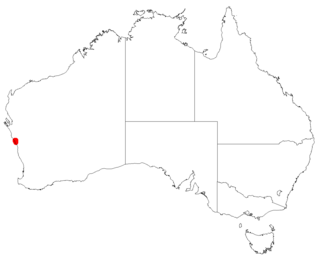Grevillea kirkalocka is a species of flowering plant in the family Proteaceae and is endemic to inland Western Australia. It is a low, spreading shrub with divided leaves with sharply-pointed linear lobes and clusters of red flowers.
Micromyrtus barbata is a species of flowering plant in the family Myrtaceae and is endemic to inland areas of Western Australia. It is a shrub with small, overlapping, narrowly egg-shaped leaves and small white flowers arranged singly in upper leaf axils.
Micromyrtus collina is a species of flowering plant in the myrtle family, Myrtaceae and is endemic to a small area in the southwest of Western Australia. It is an erect shrub with small, linear to narrowly egg-shaped leaves and small white flowers that turn pink as they age.
Micromyrtus mucronulata species of the family Myrtaceae and is endemic to the Western Australia. It is a shrub with linear to narrowly egg-shaped leaves with the narrower end toward the base, and white flowers 3.0–3.5 mm (0.12–0.14 in) in diameter.
Petrophile vana is a species of flowering plant in the family Proteaceae and is endemic to Western Australia. It is a shrub with needle-shaped, sharply-pointed leaves, and spherical to oval heads of small numbers of hairy, white flowers.

Goodenia katabudjar is a species of flowering plant in the family Goodeniaceae and is endemic to a restricted area in the south-west of Western Australia. It is a hairy perennial sub-shrub with egg-shaped stem-leaves and blue, pink or white flowers.
Hibbertia graniticola is a species of flowering plant in the family Dilleniaceae and is endemic to the south-west of Western Australia. It is a shrub with thick, linear leaves and yellow flowers borne singly on the ends of branchlets, with seventeen to thirty stamens arranged around the two or three carpels.
Hibbertia lepidocalyx is a species of flowering plant in the family Dilleniaceae and is endemic to Western Australia. It is a shrub with thick, linear, cylindrical leaves and yellow flowers with nine or ten stamens in a single group on one side of the two carpels.

Brachyloma preissii is a species of flowering plant in the heath family, Ericaceae, and is endemic to Western Australia. It is an erect, dense shrub with linear to oblong leaves and red, or pinkish-red, tube-shaped flowers.

Leucopogon borealis is a species of flowering plant in the heath family Ericaceae and is endemic to a restricted area of the west of Western Australia. It is an erect shrub with hairy young branchlets, linear leaves and white flowers in nine to twenty upper leaf axils.
Stenanthemum limitatum is a species of flowering plant in the family Rhamnaceae and is endemic to the southwest of Western Australia. It is an erect or straggling shrub with sparsely hairy young stems, egg-shaped to fan-shaped leaves and greyish, softly-hairy heads of white or cream-coloured flowers.

Conostephium magnum is a species of flowering plant in the family Ericaceae and is endemic to the south-west of Western Australia. It is an erect, compact shrub with scattered lance-shaped leaves with the narrower end toward the base, and pendulous, spindle-shaped, cream-coloured to white and pink flowers arranged singly in leaf axils.
Stenanthemum sublineare is a species of flowering plant in the family Rhamnaceae and is endemic to the southwest of Western Australia. It is an erect shrub with sparsely hairy young stems, narrowly egg-shaped to linear leaves, and small clusters of densely hairy, greenish, tube-shaped flowers.
Cryptandra stellulata is a flowering plant in the family Rhamnaceae and is endemic to the southwest of Western Australia. It is a shrub with spiny branches, narrowly oblong to linear leaves and spike-like clusters of 2 to 12 white, tube-shaped flowers.
Brachyloma djerral is a species of flowering plant in the family Ericaceae and is endemic to a small area in the west of Western Australia. It is an erect, compact shrub with narrowly egg-shaped to narrowly elliptic leaves and red, tube-shaped flowers.
Brachyloma elusum is a species of flowering plant in the family Ericaceae and is endemic to a two locations in the west of Western Australia. It is an erect, compact shrub with linear to narrowly egg-shaped leaves with the narrower end toward the base, and red, tube-shaped flowers.
Brachyloma mogin is a species of flowering plant in the family Ericaceae and is endemic to the south-west of Western Australia. It is a compact shrub with linear leaves and red to pink, urn-shaped flowers.
Brachyloma nguba is a species of flowering plant in the family Ericaceae and is endemic to the south-west of Western Australia. It is a shrub with narrowly elliptic leaves on the ends of short side-branches, and red urn-shaped flowers.
Brachyloma pirara is a species of flowering plant in the family Ericaceae and is endemic a restricted area in the west of Western Australia. It is an erect, compact shrub with sharply-pointed, linear to narrowly egg-shaped or narrowly elliptic leaves, and red, tube-shaped flowers.
Brachyloma stenolobum is a species of flowering plant in the family Ericaceae and is endemic to a restricted area in the west of Western Australia. It is an erect, compact shrub with narrowly elliptic or elliptic leaves, and white, tube-shaped flowers.




